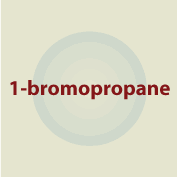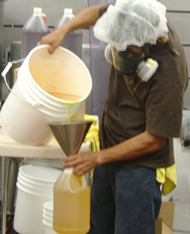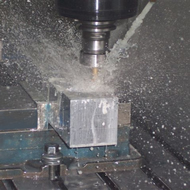 In recent years we have seen an increase in the use of the solvent 1-bromopropane (1-BP) as a substitute for ozone-depleting chlorofluorocarbons and other regulated compounds. 1-BP is used in multiple manufacturing processes, including vapor and immersion degreasing operations to clean electronics and metal and as a solvent vehicle in industries using aerosol applied adhesives such as foam cushion manufacturing. In some states, 1-BP is now being used as an alternative solvent within the dry cleaning industry in response to the restricted use of perchloroethylene, which is considered “probably carcinogenic to humans” by the International Agency for Research on Cancer (IARC).
In recent years we have seen an increase in the use of the solvent 1-bromopropane (1-BP) as a substitute for ozone-depleting chlorofluorocarbons and other regulated compounds. 1-BP is used in multiple manufacturing processes, including vapor and immersion degreasing operations to clean electronics and metal and as a solvent vehicle in industries using aerosol applied adhesives such as foam cushion manufacturing. In some states, 1-BP is now being used as an alternative solvent within the dry cleaning industry in response to the restricted use of perchloroethylene, which is considered “probably carcinogenic to humans” by the International Agency for Research on Cancer (IARC).
Selected Category: Chemicals
1-BP: A Potential Occupational Hazard
Categories: Chemicals
December 8th, 2008 3:30 pm ET - Administrator
Diacetyl and Food Flavorings
Categories: Chemicals, Respiratory health
November 10th, 2008 9:23 am ET - Lauralynn Taylor McKernan, ScD, CIH; Kevin Dunn, MSEE, CIH; Kathleen Kreiss, MD; David N. Weissman, MD
 Commercial flavorings used in the flavoring manufacturing and food production industries are often complex mixtures of flavoring chemicals, many of which are volatile, meaning that they evaporate into the air from their liquid or solid form. Diacetyl is a prominent chemical ingredient in butter flavorings and is a component of the vapors coming from these and other flavorings. Inhalation of butter flavoring chemical mixtures, including diacetyl, has been associated with severe obstructive lung disease popularly know as “popcorn lung.” In many symptomatic individuals exposed to flavoring who have undergone lung biopsy, an irreversible type of lung damage called constrictive bronchiolitis has been found. In this condition, the smallest airways carrying air through the lungs, the bronchioles, are scarred and constricted. This can decrease or block air movement through these airways.
Commercial flavorings used in the flavoring manufacturing and food production industries are often complex mixtures of flavoring chemicals, many of which are volatile, meaning that they evaporate into the air from their liquid or solid form. Diacetyl is a prominent chemical ingredient in butter flavorings and is a component of the vapors coming from these and other flavorings. Inhalation of butter flavoring chemical mixtures, including diacetyl, has been associated with severe obstructive lung disease popularly know as “popcorn lung.” In many symptomatic individuals exposed to flavoring who have undergone lung biopsy, an irreversible type of lung damage called constrictive bronchiolitis has been found. In this condition, the smallest airways carrying air through the lungs, the bronchioles, are scarred and constricted. This can decrease or block air movement through these airways.
Preventing Health Hazards from Metal Working Fluids
Categories: Chemicals
October 6th, 2008 10:06 am ET - Administrator
More than 100 million gallons of metal working fluids (MWFs) are produced every year, and more than 1 million employees are exposed to these MWFs. The National Institute for Occupational Safety and Health (NIOSH) has conducted more than 70 on-site health hazard evaluations (HHEs) of facilities with occupational exposures to MWFs or mineral oil aerosols. Although NIOSH issued guidance on recommended exposure limits (RELs) and controls for MWFs in 1998, we continue to find employees exposed to airborne concentrations of MWFs above the RELs and employees with respiratory and skin problems of the types associated with MWF exposures.
NIOSH Dose Reconstruction Program
Categories: Chemicals, Exposure
January 22nd, 2008 11:30 am ET - Larry Elliott
Introduction
John Howard, M.D.
Director, NIOSH
By virtue of our mandate to conduct research and make recommendations for the prevention of work-related injury and illness, NIOSH work touches a wide array of workplaces and occupations. Knowing this, many may still be surprised to learn that NIOSH provides scientific support to a Congressionally-mandated program that dispenses compensation and medical benefits for nuclear weapons workers who may have developed certain work-related illnesses. As you will read in this blog post, the NIOSH Office of Compensation Analysis and Support (OCAS) assists with implementing a program created by the Energy Employees Occupational Illness Compensation Program Act of 2000 by completing dose reconstructions and other technical activities.
Newer Posts
Pages
Get email updates
To receive weekly email updates about this site, enter your email address:
Site Categories
- Agriculture, forestry, and fishing
- At-risk populations
- Bloodborne pathogens
- Cancer, reproductive and cardiovascular diseases
- Chemicals
- Construction
- Economics
- Emergency response
- Ergonomics
- Exposure
- Green
- Health care
- Hearing loss
- Media
- Mining
- Nanotechnology
- Oil and gas
- Outdoor work
- Personal protective equipment
- Policy and programs
- Prevention through Design
- Respiratory health
- Sleep
- Small Business
- Sports and entertainment
- Stress
- Technology
- Total Worker Health
- Training
- Transportation
- Uncategorized
- Vehicle safety
- Violence
- Young Workers
About this Site
Contact Us:
- Centers for Disease Control and Prevention
1600 Clifton Rd
Atlanta, GA 30333 - 800-CDC-INFO
(800-232-4636)
TTY: (888) 232-6348 - cdcinfo@cdc.gov


